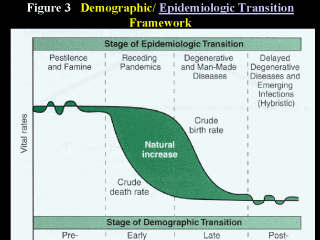| front |1 |2 |3 |4 |5 |6 |7 |8 |9 |10 |11 |12 |13 |14 |15 |16 |17 |18 |19 |20 |21 |22 |23 |24 |25 |26 |review |
 |
Source:
Ian R.H. Rockett. Population and Health: An Introduction to Epidemiology. Second edition. Population Reference Bureau 54(4); 1999: 9 The Egyptian-born demographer and health scientist, Abdel Omran, conceived the notion of the epidemiologic transition. Figure 3 reflects a four-stage depiction of the demographic transition and the superimposition of a four-stage epidemiologic transition. Omranís epidemiologic transition comprised three stages. The additional stage combines the work of other demographers that acknowledges emerging infectious diseases, such as HIV, and the rising mean age at death in the more developed countries attributable to the prevention and improved management of heart disease and stroke. References: Abdel R. Omran. The Epidemiologic Transition: A Theory of the Epidemiology of Population Change. Milbank Memorial Fund Quarterly Vol. XLIX (4); 1971:509-538. S. Jay Olshansky and Brian Ault. The Fourth Stage of the Epidemiologic Transition: The Stage of Delayed Degenerative Diseases. The Milbank Quarterly 64 (3); 1986: 355-391. Richard G. Rodgers and Robert Hackenberg. Extending Epidemiologic Theory: A New Stage. Social Biology 34 (3-4); 1987: 234-243. With appropriate acknowledgement of sources, permission to reproduce freely the three figures presented in this lecture has been granted by the Population Reference Bureau.
|